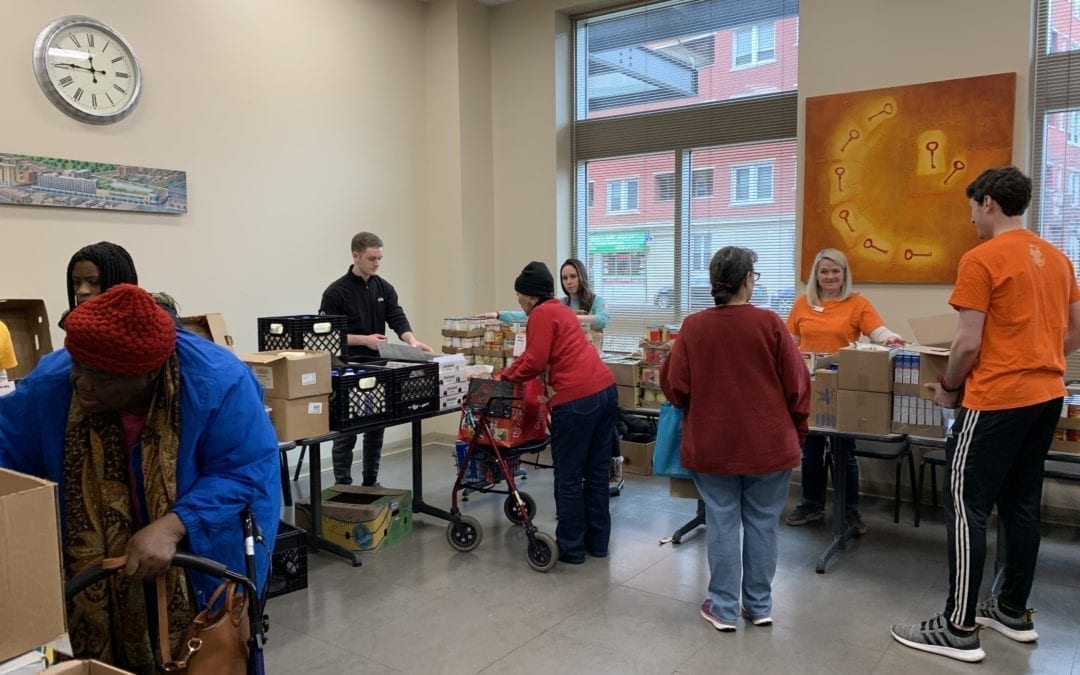(Above: Residents of Wilson Yard Apartments pick up food at our Pop-Up Pantry, providing groceries to seniors on-site.)
Food insecurity is the state of being without reliable access to a sufficient quantity of nutritious food. Seniors are especially vulnerable to food insecurity. Did you know that the rate of hunger among seniors has increased 45% since 2001? As the American Boomer generation ages into seniority, there are growing challenges to their well-being that influence food insecurity.
One factor that may be adversely impacting seniors is an increased rate of “aging in place,” or choosing to remain in their homes instead of moving into assisted living facilities. According to Freddie Mac, 63% of seniors ages 55+ report they would prefer to stay in their current residence until the end of their lives. While the benefits of remaining at home are many, there may also be some unforeseen consequences:
- Homes may need to be retro-fitted with grab bars, larger doorways, and stair lifts for safety, often at personal cost to the senior.
- As a senior’s level of functioning decreases, the senior may need assistance with personal care, housekeeping, and cooking in order to remain safe in their home. Federal programs that provide home-based support services help to meet this need, but as the demand continues to rise, it may become a bigger challenge for federal agencies to keep up, which could result in more unmet need.
- A potential decrease in nutrition. A recent report in Food Technology Magazine showed that seniors are now more likely to eat their meals in restaurants than millennials are and that 78% of restaurant visits were made to fast food establishments.
Social isolation has a huge impact on the well-being of seniors as well. The rates of reported loneliness are steadily increasing – with one third of seniors reporting that they feel lonely. Research has shown that loneliness and isolation can affect a senior’s health in many (and some unexpected) ways:
- Loneliness can actually promote inflammation in the body, which can be linked to higher rates of chronic illness.
- Doubled risk for weight loss among seniors with limited social interaction.
- Increased risk of malnutrition. On the other hand, researchers found that a higher level of social integration influences higher rates of fruit and vegetable consumption.
At Nourishing Hope, we understand that our senior clients have unique needs that may not be addressed through regular pantry distribution. Our Home Delivery Program serves those who are unable to come into our physical pantry sites in order to pick up food — homebound seniors and adults with disabilities. The program was launched in 1989 and was the first of its kind. As of 2020, the Home Delivery Program serves about 400 clients every month. In-home case management is also provided through the program, assessing the needs of our clients and assisting them with managing their SNAP and Medicaid benefits, providing referrals for services such as in-home mental health providers, homecare assistance, transportation, housing assistance, and much more.
In early 2020, Nourishing Hope launched a new program to expand services provided to homebound seniors: The Pop-Up Pantry! This program currently serves clients in a low-income resident building in Chicago’s Uptown neighborhood to “pop up” a monthly pantry in their community room. Residents of this senior building are invited to choose their own food and volunteers are on hand to assist residents back up to their apartments. Social services are also available during this distribution. We’re looking forward to continuing to grow this exciting program!
Through these programs, we are striving to meet the growing needs of our senior community. Wondering how you can help? There are volunteer opportunities available for both the Home Delivery Program and Pop-Up Pantry!
